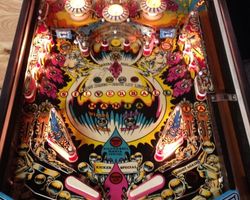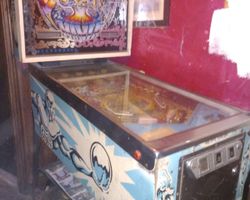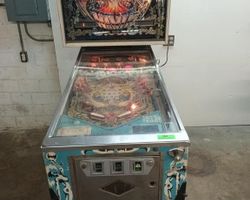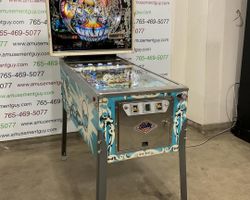Silverball Mania

Average Prices: USD $200 to $1,500
Produced: Febuary, 1980
Production Run: 10,350 units
Machine Type: Solid State Electronic
MPU: Bally MPU AS-2518-35
Players: 4
Design by: Jim Patla
Art by: Kevin OConnor, Kevin O'Connor
Bally Manufacturing Corporation unveiled Silverball Mania in February 1980, a solid-state pinball machine that quickly established its own identity through a distinctive visual style and engaging gameplay. Conceived during a pivotal era for pinball, as electronic systems were fully taking hold, Silverball Mania arrived as Model Number 1157-E, with a robust production run of 10,350 units. The game's creation involved a focused team: Jim Patla handled the playfield design, while the striking artwork was the vision of Kevin O'Connor. Rehman Merchant was responsible for the software that powered its Bally MPU AS-2518-35 board.
The machine's theme revolves around the very essence of pinball—the silver ball itself—and infuses it with a fantastical, almost ethereal aesthetic. This concept originated from Kevin O'Connor, who drew inspiration from a comic artist known for rendering everything in chrome. O'Connor translated this idea directly to the pinball machine, resulting in a cohesive theme where reflections and metallic sheens dominate the visual landscape. This artistic direction was applied meticulously; for instance, one playfield plastic features O'Connor's own Jeep Cherokee, rendered in a chrome finish. Furthermore, the reflections visible in the large silver balls depicted on the cabinet sides are, in fact, self-portraits of O'Connor, who sported a beard during the game's development. This personal touch highlights the dedicated craftsmanship poured into Silverball Mania, which O'Connor approached as a blank whitewood, shaping its entire artistic presentation from a foundational idea.
Signature Features and Design
Silverball Mania distinguishes itself immediately through its visual presentation. The artwork, particularly the backglass and playfield, stands as one of its most celebrated attributes. Kevin O'Connor's chrome-centric style permeates every element, creating an aesthetic that is both unique and captivating. The backglass depicts an array of figures, all rendered with reflective surfaces, creating a dynamic sense of depth and movement. This artistic approach not only sets the machine apart but also directly informs the "Silverball" in its title, emphasizing the central element of the game.
Beyond its artistic merit, the machine incorporates several key features that influence gameplay. It includes two flippers, three pop bumpers, and four passive bumpers that contribute to ball movement. A significant design element is the backglass carry-over feature, which, if enabled by the operator, awards players for spelling S-I-L-V-E-R-B-A-L-L through various targets on the playfield.
Perhaps the most innovative and gameplay-defining feature is the outlane kicker mechanism. Silverball Mania features a unique system where navigating the horseshoe lane or hitting the top center rollover lights a special outlane below the flippers. When lit, this outlane transforms into a kicker, propelling a ball that would otherwise drain back onto the playfield, providing a second chance. Adding to this innovative recovery system, the game incorporates unique wireforms located at the left and right outlanes. These wireforms allow a skilled player to nudge the machine precisely, routing a ball that has exited via an outlane onto these wireforms, directing it towards the center outlane/kicker for a potential return to play. This mechanic enhances the interaction between player skill and machine design, turning a potential drain into a strategic opportunity.
Playfield and Mechanics
The playfield of Silverball Mania is laid out to encourage a fluid, fast-paced game. Central to its design is the prominent horseshoe lane, a highly satisfying shot that arcs gracefully across the upper playfield. This lane is not just a high-scoring opportunity but also plays a role in activating the crucial outlane kicker feature. Below the horseshoe, two star rollovers complement the playfield's upper reaches, while eleven standup targets are strategically placed to encourage exploration of different areas of the field. Two slingshots guard the lower extremities, redirecting the ball with force and unpredictability.
The design philosophy behind Silverball Mania emphasizes flow and consistent action. The playfield encourages players to keep the ball in motion, seeking out the horseshoe for both points and feature activation. The relatively open lower playfield allows for rapid ball movement, setting up quick flipper shots. The incorporation of the outlane kicker is a deliberate design choice to extend ball times and inject a element of unexpected recovery, which can shift the momentum of a game. This feature encourages players to refine their nudging techniques, recognizing that even a ball seemingly destined for a drain can be saved with skillful manipulation of the machine.
Visually, the playfield mirrors the backglass's chrome theme. Reflections and a metallic palette dominate, with illustrations of pinball-related elements and fantastical chrome figures populating the surfaces. The lighting scheme is direct and functional, highlighting active targets and the crucial status of the outlane kicker. This consistent aesthetic, from cabinet to backglass to playfield, creates a unified and immersive experience, reinforcing the core "silverball" concept.
Gameplay Dynamics
Silverball Mania offers a gameplay experience rooted in the solid-state era's straightforward yet engaging mechanics. The primary goal is to achieve a high score, with the maximum displayed point score reaching 999,990 points per player. The scoring system rewards accuracy and sustained play, encouraging players to master the playfield's layout.
One of the central objectives involves spelling out S-I-L-V-E-R-B-A-L-L through a series of dedicated targets. Completing this sequence, if the operator has enabled the carry-over feature, can provide a substantial award. Beyond this, hitting the numerous standup targets, spinning the spinners, and navigating the star rollovers all contribute to the player's score.
The most distinctive strategic element revolves around the outlane kicker. Successfully lighting this feature by either shooting the horseshoe lane or hitting the top center rollover becomes a critical objective. Once lit, the player gains a safety net, potentially returning a ball from an outlane drain. This creates a dynamic where players might prioritize hitting these specific shots to ensure their ball times are extended, or where skilled nudges become a crucial part of an attempted save.
The game's progression is relatively simple, focusing on accumulating points and activating the outlane kicker for extended play. There are no complex multi-ball modes or intricate wizard goals; instead, the challenge lies in consistency, precision, and the ability to keep the ball in play. The satisfaction derived from a well-executed horseshoe shot, or the unexpected relief of a ball returned by the kicker, constitutes many of the game's memorable highlights. While skilled players can potentially "roll over" the score relatively easily due to the game's direct scoring mechanics, the fast flow and the ever-present chance of an outlane save ensure continued engagement.
Reception and Legacy
Silverball Mania has garnered a generally positive reception within the pinball community, primarily celebrated for its aesthetic qualities. Its artwork is frequently cited as a standout achievement, with many considering the backglass and playfield among the finest examples from the early solid-state era. The unique chrome-centric design by Kevin O'Connor gives the machine a distinct and visually appealing character that continues to resonate with collectors and players.
On the gameplay front, Silverball Mania is often praised for its fast and enjoyable flow. The horseshoe loop is a particular highlight, delivering a satisfying shot that serves as a core element of the game's appeal. The kickback feature, which offers a second chance from the outlanes, is also frequently appreciated for extending rallies and adding a strategic layer to nudging. For many, the machine evokes a strong sense of nostalgia, embodying the simplicity and direct engagement of classic pinball from its period. The sounds, while sometimes described as repetitive, are also recognized as a unique auditory signature of the game.
However, the machine is not without its criticisms. A common point of feedback centers on the potential for repetitive gameplay, as the horseshoe shot can become the dominant focus, leading to a feeling of monotony for some players over extended sessions. Critics also suggest that the rules and objectives are too straightforward, lacking the depth or complex challenges found in later designs. The sound package, while distinctive, is occasionally cited as repetitive or uninspired. Furthermore, highly skilled players have noted that the game's scoring system can be easily "rolled over," indicating a potential imbalance that limits long-term challenge for top-tier competitors.
Despite these points, the overall sentiment towards Silverball Mania remains positive. Many enthusiasts enjoy the machine, valuing it as a worthy addition to a collection. It is often viewed as a beautiful piece of art that also provides a fun, albeit simple, pinball experience. Silverball Mania's legacy is anchored in its striking visual identity, which set a high bar for artistic integration in pinball machines. It stands as a notable example of Bally's design prowess during the transition to solid-state technology, showcasing how innovative art and straightforward yet engaging mechanics could combine to create a memorable and enduring pinball experience. Its influence can be seen in the continued appreciation for bold, cohesive artistic themes in pinball, demonstrating that visual appeal can be as important as mechanical complexity in defining a machine's character and lasting appeal.
Sponsored Links
 Ebay Listings
Ebay Listings
 Auction Results
Auction Results
| Cost | Location | Date |
|---|---|---|
| GBP £1,231 |  Trowbridge, United Kingdom Trowbridge, United Kingdom |
18 August, 2025 |
| EUR €1,800 |  Baden-Württemberg, Germany Baden-Württemberg, Germany |
21 April, 2025 |
| USD $1,975 |  Indiana, United States Indiana, United States |
01 March, 2025 |
| USD $1,975 |  Indiana, United States Indiana, United States |
22 January, 2025 |
| GBP £710 |  York, United Kingdom York, United Kingdom |
07 December, 2024 |
| EUR €1,600 |  Nordrhein-Westfalen, Germany Nordrhein-Westfalen, Germany |
28 November, 2024 |
| EUR €1,990 |  Nordrhein-Westfalen, Germany Nordrhein-Westfalen, Germany |
05 November, 2024 |
| USD $925 |  Illinois, United States Illinois, United States |
25 May, 2024 |
| EUR €1,950 |  Nordrhein-Westfalen, Germany Nordrhein-Westfalen, Germany |
26 April, 2024 |
| USD $3,488 |  Florida, United States Florida, United States |
26 April, 2024 |


Private Policy · Search Website · Contact Us
As an eBay Partner, we may earn a commission from qualifying purchases made through links on this site, at no additional cost to you.
All trademarks and copyrighted materials remain property of their respective owners. All other content copyright 2007 - 2025 Pinpedia.







